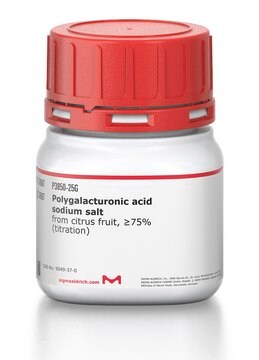P9416
TWEEN® 20
for molecular biology, viscous liquid
Synonym(s):
Polyethylene glycol sorbitan monolaurate, Polyoxyethylenesorbitan monolaurate
About This Item
Recommended Products
biological source
corn
plant (Palm)
plant (coconut)
wheat
grade
Molecular Biology
for molecular biology
description
non-ionic
Assay
>40% (GC)
form
viscous liquid
mol wt
~1228
~1228
composition
lauric acid, ≥40% (balance primarily myristic, palmitic, and stearic acids)
concentration
≥40.0% (GC)
impurities
RNAse, none detected
endonuclease, none detected
exonuclease, none detected
refractive index
n20/D 1.468 (lit.)
CMC
60 mg/L
solubility
water: 100 mg/mL, clear, colorless to yellow
density
1.095 g/mL at 25 °C (lit.)
suitability
suitable for molecular biology
foreign activity
Endonuclease-exonuclease and RNase, none detected
SMILES string
CCCCCCCCCCCC(=O)OCCOCC(C1C(C(CO1)OCCO)OCCO)OCCO
InChI
1S/C26H50O10/c1-2-3-4-5-6-7-8-9-10-11-24(30)34-19-18-31-20-22(32-15-12-27)26-25(35-17-14-29)23(21-36-26)33-16-13-28/h22-23,25-29H,2-21H2,1H3
InChI key
HMFKFHLTUCJZJO-UHFFFAOYSA-N
Looking for similar products? Visit Product Comparison Guide
General description
Surfactants, possessing both hydrophilic and hydrophobic components, fall into two main categories: ionic, which ionize in water (anionic, cationic, or ampholytic), and nonionic, which do not ionize. The discussed product is a nonionic surfactant with diverse applications such as emulsification, dispersion, solubilization, and detergent use. Additionally, it can serve as a solubilizer for membrane proteins.
Application
- As an emulsifying agent for the preparation of stable oil-in-water emulsions
- In pre-extraction of membranes to remove peripheral proteins (used at 2% for extraction of membrane-bound proteins)
- As a blocking agent for membrane based immunoassays at a typical concentration of 0.05%
- For lysing mammalian cells at a concentration of 0.005 to 0.5%
- Along with PBS in the dilution of antibodies in immunohistochemistry technique
- For washing cells in FISH (Fluorescence in situ hybridization) technique
Features and Benefits
- Highly versatile surfactant for your Life Science and Biochemical research
- Suitable for sensitive molecular biology research applications
- Tested for Endonuclease, exonuclease and Rnase′s
- Excellent solubilising, dispersing and emulsifying agent
Caution
Preparation Note
Other Notes
Legal Information
comparable product
Storage Class Code
10 - Combustible liquids
WGK
WGK 1
Flash Point(F)
527.0 °F - Pensky-Martens closed cup
Flash Point(C)
275 °C - Pensky-Martens closed cup
Personal Protective Equipment
Choose from one of the most recent versions:
Already Own This Product?
Find documentation for the products that you have recently purchased in the Document Library.
Customers Also Viewed
Protocols
cAMP measurements are obtained using an ELISA assay (Harlow and Lane 1988). Commercial radio-immunoassays, or ELISA kits, to assay cAMP can be purchased from various manufacturers.
Membrane-based blotting applications that employ enzyme conjugates to generate colorimetric or chemiluminescent signal require the use of an added blocking step to decrease the signal generated by non-specific binding.
In Situ Hybridization of Whole-Mount Mouse Embryos with RNA Probes: Hybridization, Washes, and Histochemistry. This is a protocol describing how to perform in situ hybridization on whole mouse embryos. Here we describe the hybridization procedure, and the localization of the DIG-labeled RNA using a conjugate of anti-DIG Fab antibody and calf intestinal alkaline phosphatase. Enzyme activity of the reporter is detected by a color reaction, resulting in the formation of a water-insoluble purple/blue precipitate. Manipulating the Mouse Embryo - Third Edition
Related Content
Three-dimensional (3D) printing of biological tissue is rapidly becoming an integral part of tissue engineering.
Our team of scientists has experience in all areas of research including Life Science, Material Science, Chemical Synthesis, Chromatography, Analytical and many others.
Contact Technical Service






